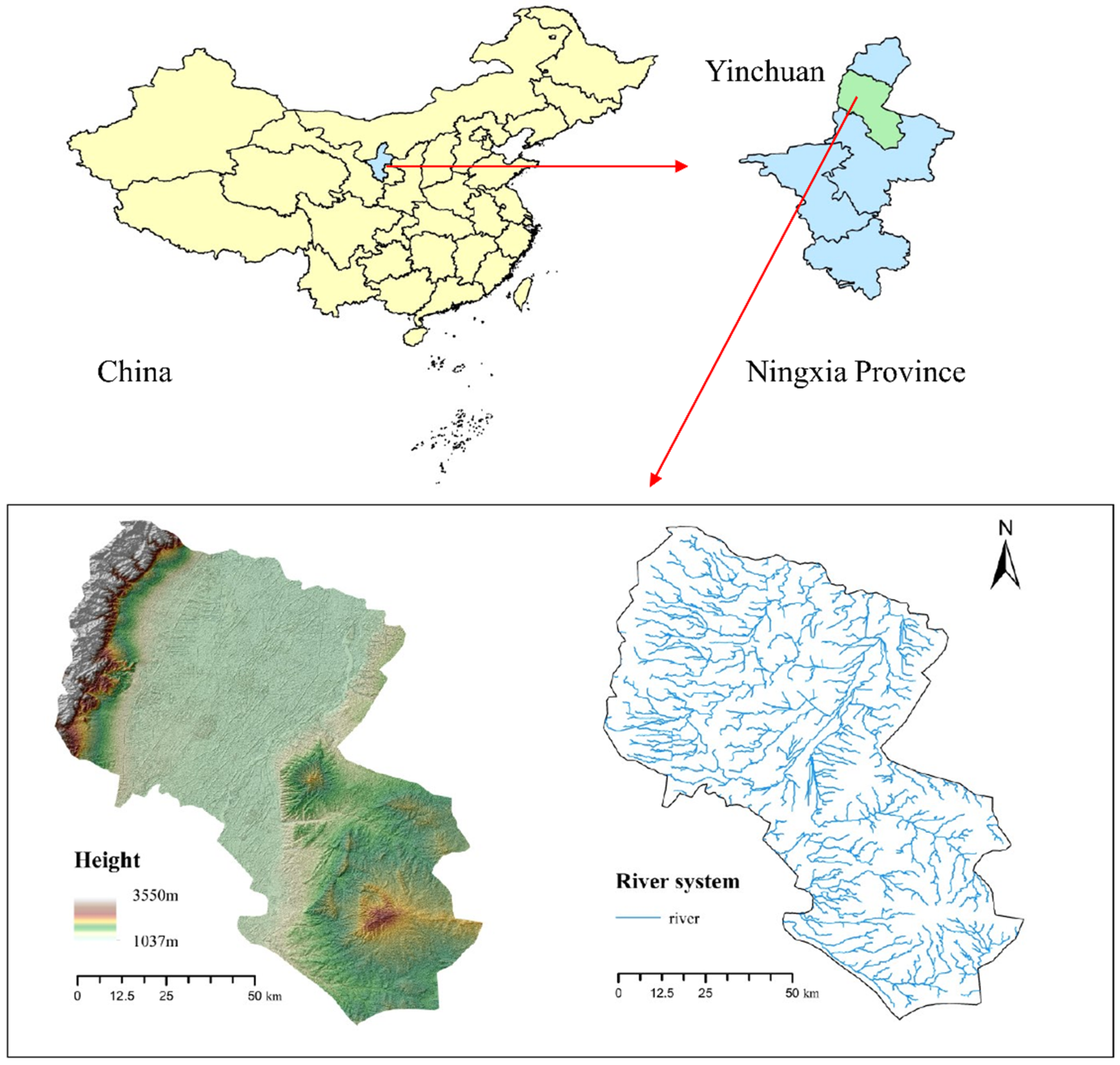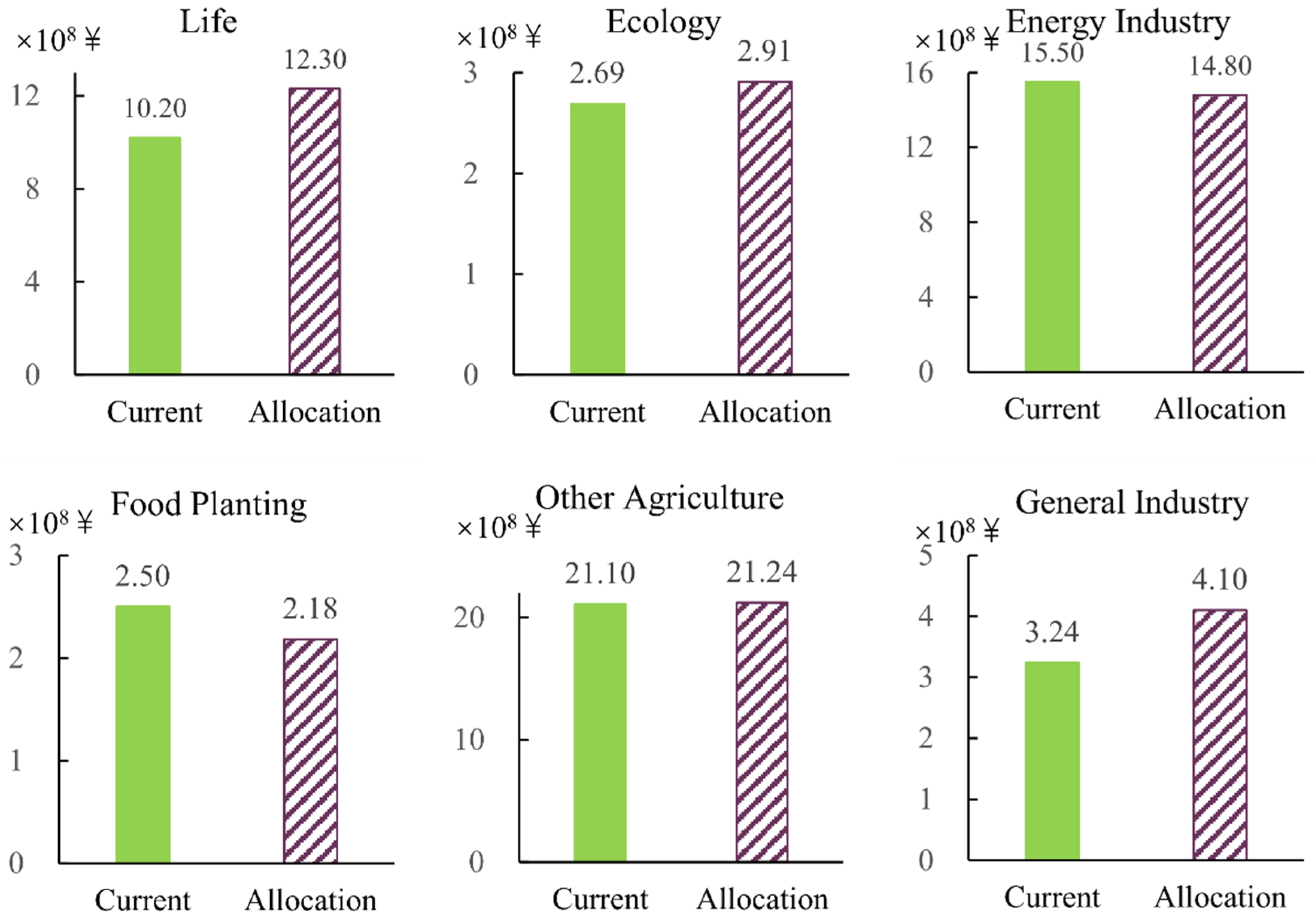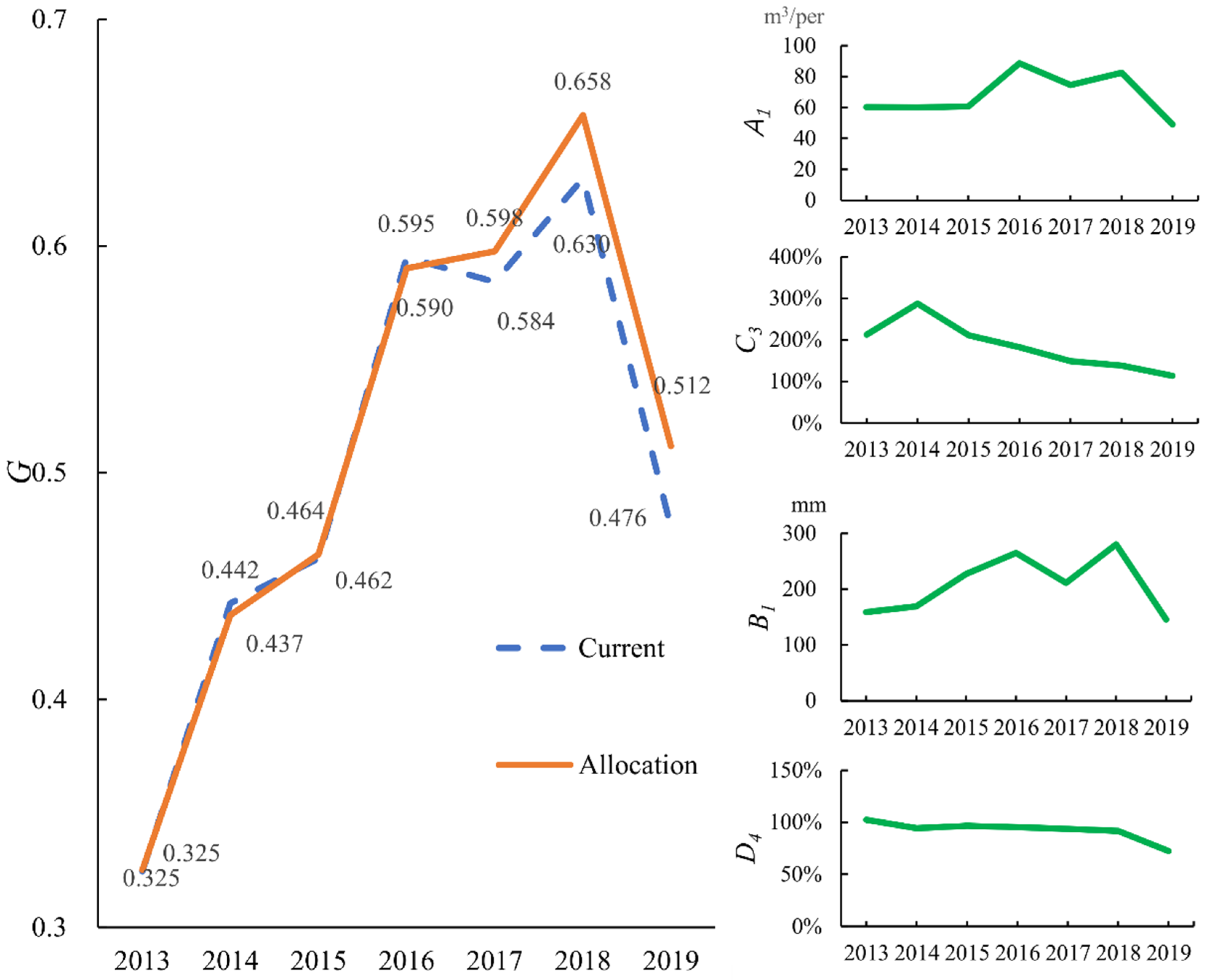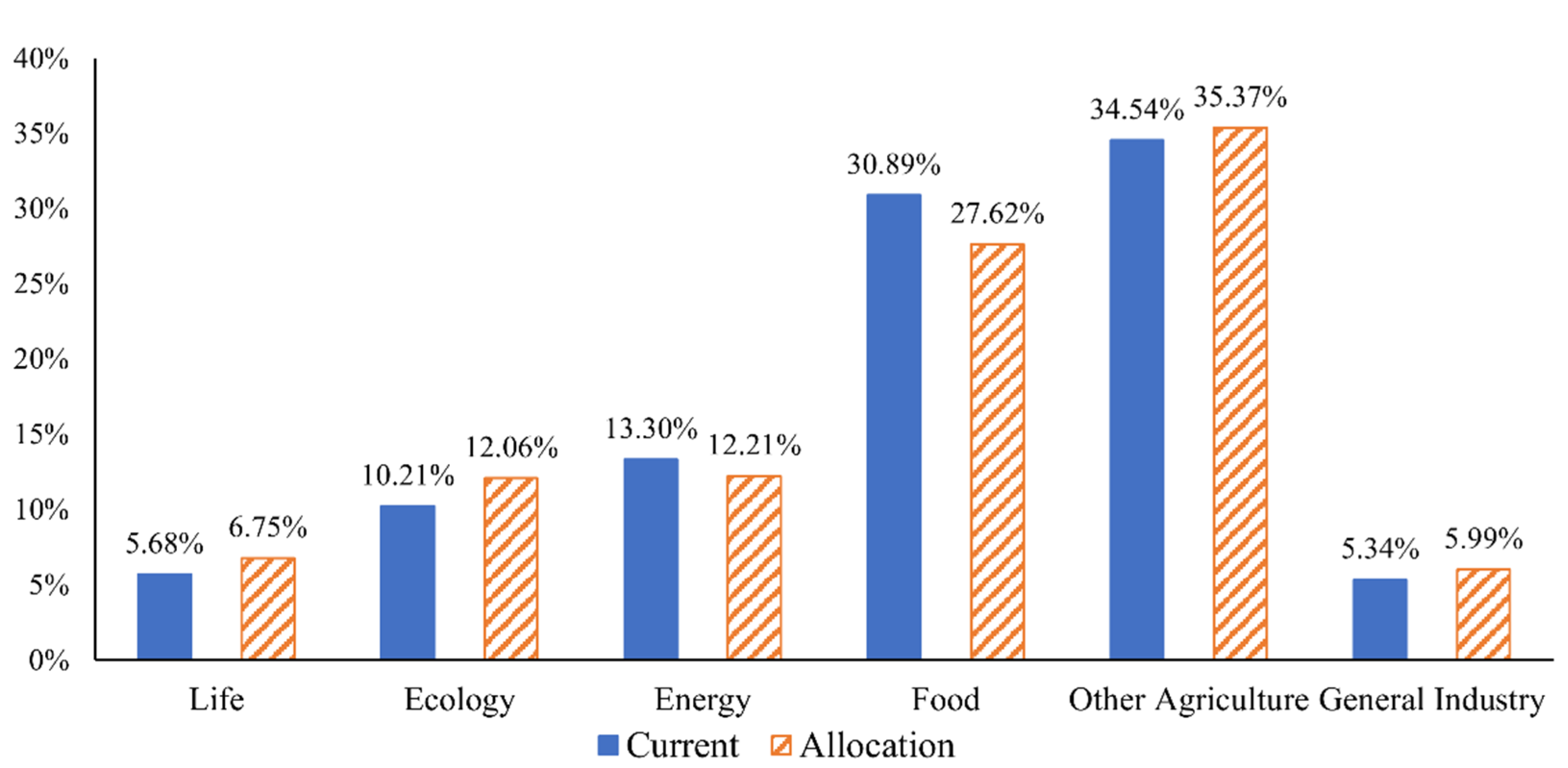Research on Water Rights Allocation of Coordinated Development on Water–Ecology–Energy–Food
Abstract
:1. Introduction
2. Materials and Methods
2.1. The Correlation Theory
2.1.1. The Concept and Basic Principles of Water Rights Allocation
2.1.2. The Definition of Coordinated Development on Water–Ecology–Energy–Food
2.2. Regional Overview of the Study Area
2.3. Construction of the Water Rights Allocation Model
2.3.1. The Objective Function of Fairness
2.3.2. The Objective Function of Efficiency
- (1)
- Water resources benefit life, energy, food planting, other agricultural systems, and the general industry
- (2)
- The water resources benefit for ecology
- (3)
- The efficiency objective function of water rights allocation established according to the above items is:where RS is the objective function of efficiency.
2.3.3. The Objective Function of Coordinated Development
- (1)
- The selection of comprehensive evaluation indicators for coordinated development is shown in Table 1.
- (2)
- The coordinated development index can be quantified with the entropy weight method:
- (A)
- Normalization treatmentwhen the indicator is positivewhen the indicator is negativewhere yij is normalized data; max(xj) is the maximum indicator j in n years; and min(xj) is the minimum indicator j in n years.
- (B)
- The calculation of the indexCalculate the weight of the indicator in the year i under the index j:Calculate the information entropy of indicator j:Determine the weight of indicator j:Calculate the coordinated development indicator Gi in the year i:
- (C)
- The objective function of coordinated developmentwhere RG is the objective function of the coordinated development on water–ecology–energy–food.
2.3.4. The Constraints of Industry Water Rights
- (1)
- The constraints of water rights of life:where WL is the water rights of life (m3); PU, PR are the number of urban people and rural people; NU, NR are the population growth rate of urban and rural; QU, QR are the per capita domestic water quota for urban and rural; GDPUP is the GDP of urban public industry; NUP is GDP growth rate of urban public industry; and MGDP is the water consumption per CNY 10,000 GDP; a is the year for future domestic water security.
- (2)
- The constraints of water rights of ecology:where WE is the water rights of ecology (m3); SG is the greening coverage area; MG is the quota for greening irrigation; SL is the area of artificial lake; EL is the evaporation supply quota of local lakes; KL is the infiltration supply quota of local lakes; SR is the area of urban roads; and MR is quota of urban road sprinkling.
- (3)
- The constraints of water rights of energy industry:where WN is the water rights of energy industry (m3); RNk is the production of energy k; MNk is the water quota for the exploitation or processing of energy k.
- (4)
- The constraints of water rights of food planting:
- (5)
- The constraints of water rights of other agriculture:where WO is the water rights of other agriculture (m3); ROk is the production of other agriculture k; MOk is the water quota of other agriculture.
- (6)
- The constraints of water rights of general industry:where WI is the water rights of general industry (m3); RIk is the production of general industry k; MIk is the water quota of general industry.
- (7)
- The constraints of total water rights:where WR is the total water rights in this city.
- (8)
- The method to solve model
3. Results
4. Discussion
4.1. Results Analysis of Water Resources Value in Various Industries
- (1)
- Comparison of the water resources value in various industries under current water rights and allocated water rights. In the efficiency objective of city-industry water rights allocation model, the emergy method is used to calculate the value of water resources in various industries in this paper. The comparison of water resources value in various industries before and after water rights allocation is shown in Figure 2:
- (2)
- Comparison of the value of water resources per cubic meter in various industries. According to the calculation of the value of water resources and the allocation results of water rights in various industries, the value of water resources per cubic meter in Yinchuan city can be obtained. The value of water resources per cubic meter of the living system is the highest, reaching 15.54 CNY/m3, followed by that of the energy industry system, reaching 10.28 CNY/m3, and that of the food production system is the lowest, only 0.67 CNY/m3. The value of water resources per cubic meter in the ecosystem is 2.05 CNY/m3, that of other agricultural systems is 4.94 CNY/m3, and that of general industrial systems is 5.37 CNY/m3. Wang Yu et al. [44] used the emergy method to calculate the value of water resources per cubic meter of the four sectors (life, industry, extra-river ecology, and agriculture) in nine provinces and autonomous regions in the Yellow River Basin. They also obtained the result that the value of water resources per cubic meter of life sector is the largest and that of the agriculture sector is the smallest. Li et al. [43] also suggested that the value of water resources per cubic meter of agriculture is minimal. The food planting industry is faced with the problem of low water efficiency, and it is a trend that accelerates the development of regional water-saving agricultural engineering renovation.
4.2. Results Analysis of Coordinated Development Index G
4.3. Results Analysis of Water Rights Allocation
5. Conclusions
- (1)
- Water, ecology, energy, and food crises are major challenges to current global development. These four resources are intertwined and affect each other, and can therefore not be discussed individually. Therefore, starting from their coordinated development, they can better solve the crisis. The quantitative method of water–ecology–energy–food coordinated development constructed in this study, and the quantitative calculation results of Yinchuan coordinated development, can provide management reference for management departments;
- (2)
- In this paper, the emergy method is used to achieve a unified and objective quantitative calculation of the value of water resources in various industries, which makes the result of water rights allocation more reliable. At the same time, it also has certain fairness significance. The Emergy method can realize the unified quantification of the economic, social, and ecological environmental value of water resources. The value of water resources calculated by this method is more scientific and reasonable;
- (3)
- The water rights allocation model of regional water–ecology–energy–food coordinated development established in this paper has ensured the water security of ecological restoration, key energy industries, and food planting. It can take reference and help for effectively solving the contradiction between the supply and demand of regional water resources, promoting the harmony of water use in various industries. It can also promote the sustainable development of economy, society, and ecology.
Author Contributions
Funding
Institutional Review Board Statement
Informed Consent Statement
Data Availability Statement
Conflicts of Interest
References
- Deng, C.; Wang, H.; Hong, S.; Zhao, W.; Wang, C. Meeting the challenges of food-energy-water systems in typical mega-urban regions from final demands and supply chains: A case study of the Bohai mega-urban region, China. J. Clean. Prod. 2021, 320, 128663. [Google Scholar] [CrossRef]
- Lai, Y. A Study on Regional Characteristics of China’s Water-Energy-Food Synergy Demand. Beijing Plan. Rev. 2019, 1, 74–77. [Google Scholar]
- Sun, C.; Yan, X. Security evaluation and spatial correlation pattern analysis of water resources-energy-food nexus coupling system in China. Water Resour. Prot. 2018, 34, 1–8. [Google Scholar]
- Brenda, C.; Aurora del, C.; José, M. A water-energy-food security nexus framework based on optimal resource allocation. Environ. Sci. Policy 2022, 133, 1–16. [Google Scholar] [CrossRef]
- Hao, L.; Wang, P.; Yu, J.; Ruan, H. An integrative analytical framework of water-energy-food security for sustainable development at the country scale: A case study of five Central Asian countries. J. Hydrol. 2022, 607, 127530. [Google Scholar] [CrossRef]
- Chen, R. Preliminary study on water resources regulation model in western basin based on Ecological Reconstruction. Bull. Chin. Acad. Sci. 2005, 20, 37–41. [Google Scholar] [CrossRef]
- Mu, L.; Liu, Y.; Chen, S. Alleviating water scarcity and poverty through water rights trading pilot policy: A quasi-natural experiment based approach. Sci. Total Environ. 2022, 823, 153318. [Google Scholar] [CrossRef]
- Smajgl, A.; Ward, J.; Pluschke, L. The water-food-energy nexus-realizing a new paradigm. J. Hydrol. 2016, 533, 533–540. [Google Scholar] [CrossRef]
- Jalilov, S.M.; Keskinen, M.; Varis, O.; Amer, S. Managing the water-energy-food nexus: Gains and losses from new water development in Amu Darya River basin. J. Hydrol. 2016, 539, 648–661. [Google Scholar] [CrossRef]
- Scanlon, B.R.; Ruddell, B.L.; Reed, P.M.; Hook, R.I.; Zheng, C.; Tidwell, V.C.; Siebert, S. The food-energy-water nexus: Transforming science for society. Water Resour. Res. 2017, 53, 3550–3556. [Google Scholar] [CrossRef]
- Hertel, T.; Steinbuks, J.; Baldos, U. Competition for land in the global bioeconomy. Agric. Econ. 2012, 44, 129–138. [Google Scholar] [CrossRef]
- Howells, M.; Hermann, S.; Welsch, M.; Bazilian, M.; Segerström, R.; Alfstad, T.; Gielen, D.; Rogner, H.; Fischer, G.; van Velthuizen, H.; et al. Integrated analysis of climate change, land-use, energy and water strategies. Nat. Clim. Change 2013, 3, 621–626. [Google Scholar] [CrossRef]
- Jeswani, H.K.; Burkinshaw, R.; Azapagic, A. Environmental sustainability issues in the food-energy-water nexus: Breakfast cereals and snacks. Sustain. Prod. Consum. 2015, 2, 17–28. [Google Scholar] [CrossRef]
- Wu, L.; Elshorbagy, A.; Pande, S.; Zhuo, L. Trade-offs and synergies in the water-energy-food nexus: The case of Saskatchewan, Canada. Resour. Conserv. Recycl. 2021, 164, 105192. [Google Scholar] [CrossRef]
- Núñez-López, J.M.; Rubio-Castro, E.; Ponce-Ortega, J.M. Involving resilience in optimizing the water-energy-food nexus at macroscopic level. Process Saf. Environ. Prot. 2021, 147, 259–273. [Google Scholar] [CrossRef]
- Chen, J.; Chen, L.; Liu, L.; Zhi, Y. Safety evaluation of regional Mater-Energy-Food system based on Pressure-State-Response model. In Proceedings of the Chinese Soft Science Anthology of China Soft Science Research Association in 2019, Beijing, China, 23–24 November 2020; pp. 127–137. [Google Scholar] [CrossRef]
- Zhang, H. Comprehensive Evaluation and Coupling Coordination Analysis of Water, Energy and Food Systems in China. Master’s Thesis, Lanzhou University, Lanzhou, China, 2019. [Google Scholar]
- Gómez-Limón, J.A.; Gutiérrez-Martín, C.; Montilla-López, N.M. Agricultural Water Allocation under Cyclical Scarcity: The Role of Priority Water Rights. Water 2020, 12, 1835. [Google Scholar] [CrossRef]
- Zahra, G.; Saeid, S. Multi-objective optimization of quantitative-qualitative operation of water resources systems with approach of supplying environmental demands of Shadegan Wetland. J. Environ. Manag. 2021, 292, 112769. [Google Scholar] [CrossRef]
- Peng, S.; Zheng, X.; Wang, Y.; Jiang, G. Coordinated optimization of water resources, energy and grain in the Yellow River Basin. Adv. Water Sci. 2017, 28, 681–690. [Google Scholar] [CrossRef]
- Zheng, H.; Wang, Z.; Zhao, J. Distribution, Management and Trade of Water Rights—Theory, Technology and Practice; China Water & Power Press: Beijing, China, 2019. [Google Scholar]
- Haken, H.; Wunderlin, A.; Yigitbasi, S. An introduction to Synergetics; Kluwer Academic Publishers: Dordrecht, The Netherlands, 1995. [Google Scholar]
- Odum, H.T.; Odum, E.C.; Blisseltt, M. Ecology and economy: Emergy analysis and public policy in Texas. In Results of Policy Research Project; LBI School of Public Affairs, State Department of Agriculture: Austin, TX, USA, 1987. [Google Scholar]
- Odum, H.T. Environmental Accounting: Emergy and Decision Making; Wiley: New York, NY, USA, 1996. [Google Scholar]
- Lv, C.; He, Y.; Zhang, W.; Gu, C.; Li, Y.; Yan, D. Quantitative Analysis of Eco-economic Benefits of Urban Reclaimed Water Greening Based on Emergy Theory. Water Resour. Manag. 2021, 35, 5029–5047. [Google Scholar] [CrossRef]
- Lv, C.; Zhang, W.; Ling, M.; Li, H.; Zhang, G. Quantitative analysis of eco-economic benefits of reclaimed water for controlling urban dust. Environ. Geochem. Health 2020, 42, 2963–2973. [Google Scholar] [CrossRef]
- Liu, X.; Cao, Y. Evaluation of regional coordinated development from the perspective of two oriented Society—An Empirical Analysis Based on Changsha Zhuzhou Xiangtan Urban Agglomeration. Sci. Technol. Prog. Policy 2011, 28, 108–113. [Google Scholar] [CrossRef]
- Li, M.; Liu, L. A comprehensive evaluation study on the level of urban-rural coordinated development—An Empirical Study Based on the data of Hubei Province. Financ. Account. Mon. 2021, 22, 144–150. [Google Scholar] [CrossRef]
- Yinchuan Water Conservancy Bureau. The Water Resources Bulletin of Yinchuan City (2013–2019); Yinchuan Water Conservancy Bureau Publications: Yinchuan, China, 2013. [Google Scholar]
- Yinchuan Water Conservancy Bureau. The Water Resources Bulletin of Yinchuan City (2013–2019); Yinchuan Water Conservancy Bureau Publications: Yinchuan, China, 2014. [Google Scholar]
- Yinchuan Water Conservancy Bureau. The Water Resources Bulletin of Yinchuan City (2013–2019); Yinchuan Water Conservancy Bureau Publications: Yinchuan, China, 2015. [Google Scholar]
- Yinchuan Water Conservancy Bureau. The Water Resources Bulletin of Yinchuan City (2013–2019); Yinchuan Water Conservancy Bureau Publications: Yinchuan, China, 2016. [Google Scholar]
- Yinchuan Water Conservancy Bureau. The Water Resources Bulletin of Yinchuan City (2013–2019); Yinchuan Water Conservancy Bureau Publications: Yinchuan, China, 2017. [Google Scholar]
- Yinchuan Water Conservancy Bureau. The Water Resources Bulletin of Yinchuan City (2013–2019); Yinchuan Water Conservancy Bureau Publications: Yinchuan, China, 2018. [Google Scholar]
- Yinchuan Water Conservancy Bureau. The Water Resources Bulletin of Yinchuan City (2013–2019); Yinchuan Water Conservancy Bureau Publications: Yinchuan, China, 2019. [Google Scholar]
- Yinchuan Bureau of Statistics. The Statistical Yearbook of Yinchuan (2014); China Statistics Press: Beijing, China, 2014. [Google Scholar]
- Yinchuan Bureau of Statistics. The Statistical Yearbook of Yinchuan (2015); China Statistics Press: Beijing, China, 2015. [Google Scholar]
- Yinchuan Bureau of Statistics. The Statistical Yearbook of Yinchuan (2016); China Statistics Press: Beijing, China, 2016. [Google Scholar]
- Yinchuan Bureau of Statistics. The Statistical Yearbook of Yinchuan (2017); China Statistics Press: Beijing, China, 2017. [Google Scholar]
- Yinchuan Bureau of Statistics. The Statistical Yearbook of Yinchuan (2018); China Statistics Press: Beijing, China, 2018. [Google Scholar]
- Yinchuan Bureau of Statistics. The Statistical Yearbook of Yinchuan (2019); China Statistics Press: Beijing, China, 2019. [Google Scholar]
- Yinchuan Bureau of Statistics. The Statistical Yearbook of Yinchuan (2020); China Statistics Press: Beijing, China, 2020. [Google Scholar]
- Li, R.; Guo, P.; Li, J. Regional Water Use Structure Optimization Under Multiple Uncertainties Based on Water Resources Vulnerability Analysis. Water Resour. Manag. 2018, 32, 1827–1847. [Google Scholar] [CrossRef]
- Wang, Y.; Peng, S.; Wu, J.; Chang, J.; Zhou, X.; Shang, W. Research on the theory and model of water resources equilibrium regulation in the Yellow River basin. J. Hydraul. Eng. 2020, 51, 44–55. [Google Scholar] [CrossRef]
- Xia, C.; Pahl-Wostl, C. The Development of Water Allocation Management in The Yellow River Basin. Water Resour. Manag. 2012, 26, 3395–3414. [Google Scholar] [CrossRef]




| System | Indicator | Unit | Indicator Attribute |
|---|---|---|---|
| Water | Per capita water resources (a1) | m3/pc | + |
| Utilization ratio of water resources (A2) | % | − | |
| Utilization ratio of groundwater resources (A3) | % | − | |
| Utilization ratio of unconventional water (A4) | % | + | |
| Water consumption of 104 CNY GDP (A5) | m3/104 CNY | − | |
| Ecology | Annual precipitation (b1) | mm | + |
| Green space coverage rate (B2) | % | + | |
| Per capita green area (B3) | m2/pc | + | |
| Energy | Per capita energy production (c1) | tce/pc | + |
| Energy consumption of 104 CNY GDP (C2) | tce/104 CNY | − | |
| Energy self-sufficiency rate (C3) | % | + | |
| Food | Per capita cultivated area (d1) | m2/pc | + |
| Per capita food production (D2) | kg/pc | + | |
| Proportion of added value in primary industry (D3) | % | − | |
| Food self-sufficiency rate (D4) | % | + | |
| Water–ecology | Proportion of water rights in ecology (ab1) | % | + |
| Water–energy | Water consumption of per unit energy production (ac1) | m3/tce | − |
| Proportion of water rights in energy industry (AC2) | % | − | |
| Proportion of water rights in general industry (AC3) | % | − | |
| Water–food | Proportion of water rights in food planting (ad1) | % | − |
| Irrigation water consumption of Per unit cultivated area (AD2) | m3/hm2 | − | |
| Coefficient of irrigation water effective utilization (AD3) | + | ||
| Ecology–energy | Proportion of clean energy generation (bc1) | % | + |
| Ecology–food | Application amount of chemical fertilizer Per unit cultivated area (bd1) | t/hm2 | − |
| Energy–food | Agricultural machinery power per unit cultivated area (cd1) | kw/hm2 | − |
| Proportion of energy consumption in primary industry (CD2) | % | − | |
| Economic | Per capita gdp (j1) | 104 CNY/pc | + |
| GDP growth rate (J2) | % | + | |
| Proportion of added value in tertiary industry (J3) | % | + | |
| Social | Proportion of water rights in life (h1) | % | + |
| Rate of population growth (H2) | ‰ | − | |
| Engel Co-efficient (H3) | % | − | |
| Urbanization rate (H4) | % | + | |
| Population density (H5) | pop/km2 | − | |
| Environment | Sewage treatment rate (z1) | % | + |
| Greenhouse gas emission per 104 CNY GDP created (Z2) | kg/104 CNY | − |
| Industry | Water Rights of Life WL | Water Rights of Ecology WE | Water Rights of Energy Industry WN | Water Rights of Food Planting WF | Water Rights of Other Agriculture WO | Water Rights of General Industry WI | Total |
|---|---|---|---|---|---|---|---|
| Water rights (×108 m3) | 0.99 | 1.77 | 1.80 | 4.06 | 5.20 | 0.88 | 14.70 |
Publisher’s Note: MDPI stays neutral with regard to jurisdictional claims in published maps and institutional affiliations. |
© 2022 by the authors. Licensee MDPI, Basel, Switzerland. This article is an open access article distributed under the terms and conditions of the Creative Commons Attribution (CC BY) license (https://creativecommons.org/licenses/by/4.0/).
Share and Cite
Zhang, W.; He, Y.; Yin, H. Research on Water Rights Allocation of Coordinated Development on Water–Ecology–Energy–Food. Water 2022, 14, 2140. https://doi.org/10.3390/w14132140
Zhang W, He Y, Yin H. Research on Water Rights Allocation of Coordinated Development on Water–Ecology–Energy–Food. Water. 2022; 14(13):2140. https://doi.org/10.3390/w14132140
Chicago/Turabian StyleZhang, Wenge, Yifan He, and Huijuan Yin. 2022. "Research on Water Rights Allocation of Coordinated Development on Water–Ecology–Energy–Food" Water 14, no. 13: 2140. https://doi.org/10.3390/w14132140
APA StyleZhang, W., He, Y., & Yin, H. (2022). Research on Water Rights Allocation of Coordinated Development on Water–Ecology–Energy–Food. Water, 14(13), 2140. https://doi.org/10.3390/w14132140





